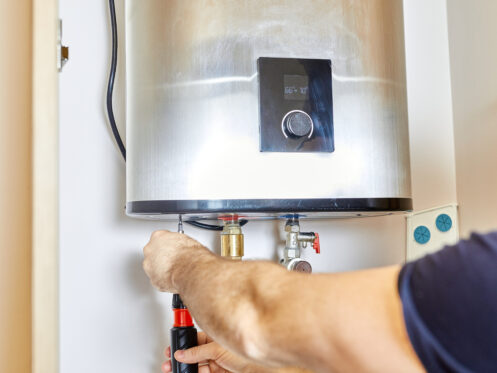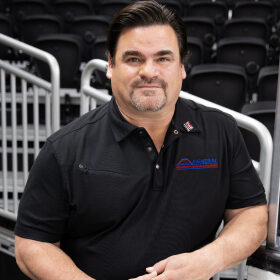Traditional water heaters store water in a tank and must keep it at the right temperature for when you need it. Tankless water heaters, on the other hand, heat water on demand. Also known as instantaneous and on-demand water heaters, they’re among the hottest trends in Palm Springs home improvement. Let’s explore the reasons you may want to upgrade, too.
Unlimited Hot Water With Accurate Sizing
Tank water heaters have a limited capacity, which is usually 40-50 gallons for the average home. Recovery times can’t keep up with excessive usage. If you run out of water, you’re out until the system recovers, which could be an hour or more. Tankless systems have a flow rate rather than a capacity. As long as demand remains under that flow rate, you’ll never run out. Even if there’s excessive demand, you won’t run out. There will be low water pressure, but you can just turn off one or more fixtures or appliances.
Reduced Operating Costs
Tank water heaters are inherently less efficient because they continue using power or fuel to keep water heated. Tankless systems only use power or fuel when you’re using hot water. How much you’ll save each year depends on the type of system. The average home will save more than $40 annually with an electric tankless water heater. Smaller homes will save even more. With a fuel-burning tankless water heater, the average home will save more than $100 yearly. That means you’ll easily save more than $1,000 over the life of the system.
Longer Lifespan and Lower Total Costs
The traditional water heater lasts about 10 years on average. A tankless water heater will last at least 15 years and can remain efficient for 20-25 years with proper maintenance. There are just fewer components that can become inefficient and fail over time. On-demand systems do cost more to purchase and install. Still, you’ll easily recoup that added cost through longevity alone. The lower operating cost is another reason the total cost of ownership is lower with tankless systems.
The Option to Size for More Capacity Than You Need Daily
It’s very important to size tank systems accurately. You’ll run out of hot water if the tank is too small. You’ll also drive up your operating costs considerably with a tank that’s too large. With a tankless system, you have to at least size it for your peak demand. That said, you can feel free to size it beyond that flow rate. It will cost you more at the time of purchase and when you use the additional capacity. This will not cost you more on a daily basis as it would with a tank system. This means that you can size your water heater for big family gatherings and other events.
Smaller Household Carbon Footprint
The U.S. Department of Energy (DOE) estimates that water heating accounts for 18% of the average American household’s energy consumption. By lowering it, you can make a significant difference in your carbon footprint. How much of a difference depends on household hot water consumption. If you’re average, which is about 41 gallons or less, energy savings will be 24%-34%. Savings will decrease as you go up in usage. The lowest point is 8%-14% if you use 81 gallons or more a day.
Smaller Installation Footprint
Many homes have a dedicated closet just to accommodate the space necessary for a large tank. This is unnecessary with tankless systems. You can reuse your water heater closet if you like, or you could repurpose it. You can install an on-demand system wherever you can mount it, and there’s not much weight to be concerned about. Many homeowners install it in the garage where it takes up no storage space at all. Others like it out of sight, such as in the attic or basement.
The Option for an Outdoor Install
You can even install it outdoors, which typically isn’t possible with a tank system. This is often a compelling option for homeowners with older houses. Due to the way installers used to set up plumbing, the interior plumbing may need upgrades. That could be a significant additional cost. By installing the water heater outside, you avoid those challenges, and the installation is much simpler.
Recirculating Pumps and Compact Storage Tanks
Old tankless water heater designs could have potential issues. One is having to wait a long time when turning on a faucet. Another is the cold-water sandwich effect, which mostly affects showers. Manufacturers have largely eliminated these issues with modern designs. Many tankless systems include a recirculating pump. Others have a small compact storage tank, and some models even have both upgrades.
Multi-Unit Installations
Tankless water heater installation gets more challenging the larger the home is. Upgrades like recirculating pumps and compact tanks have made it easier. Another modern option is a zoned system. This is where you break the home up into zones and serve each zone with its own tankless water heater. It’s a more expensive approach initially, but it can save large households significant money over a couple of decades.
Less Risk of Water Damage
A big concern with tank water heaters is that they can leak over time. These tank failures can be sudden and substantial. The average tank can dump 50 gallons of water onto a floor, and that can cause a lot of damage. There’s no risk of this with a tankless system. They can leak, but it’s generally limited to dripping. Often, it’s fixable by tightening a connection or replacing a washer.
Longer and More Robust Warranty Coverage
Tankless water heaters have a longer expected lifespan. Manufacturers reflect this through the warranties they provide. Typical warranties for tankless systems provide coverage for twice as long as tank models. There are brands that provide 20- and 25-year warranties. The base coverage is typically more robust. Brands also tend to give more options when for extending and expanding the warranties.
Energy Incentives
There are incentives available for many tankless water heaters that can help lower your initial investment. Note that for most incentives, you’ll need to target a fuel-burning water heater and one with ENERGY STAR certification. ENERGY STAR is a U.S. EPA program focused on the energy efficiency of consumer products. Products with the label have met or exceeded the EPA standards through testing by an independent lab. The federal tax credit is worth 30% of the total installation cost up to $1,200. Rebates are available through local organizations, including utility companies. You can check for those by zip code through the ENERGY STAR website.
Expert Tankless Water Heater Installation in Palm Springs
General Air Conditioning & Plumbing is located in Thousand Palms, CA and has been serving Palm Springs and the surrounding areas since 1984. Our plumbers perform leak repair, drain services, and plumbing installations and repairs. That includes kitchen and bathroom fixtures, tank and tankless water heaters, water filtration systems, and water softening systems.
Our electricians install electrical panels, indoor and outdoor lighting, and whole-home generators. We perform wiring and rewiring, including for pools, hot tubs, and spas. Our HVAC technicians install and service furnaces, heat pumps, air conditioners, and ductless mini-splits. You can also count on us for duct cleaning, air purifiers, UV treatment, dehumidifiers, and humidifiers. Contact us today with any questions to schedule a plumbing service appointment or on-site consultation.


